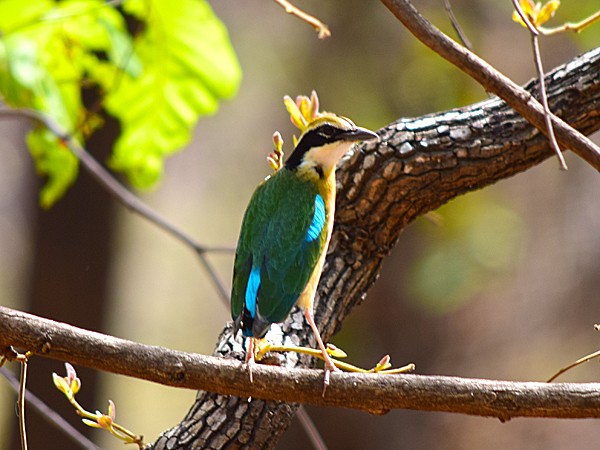Indian Pitta
A species of Typical Pittas Scientific name : Pitta brachyura Genus : Typical Pittas
Indian Pitta, A species of Typical Pittas
Botanical name: Pitta brachyura
Genus: Typical Pittas
Content
Description General Info
 Photo By Sudipta Nandy , used under CC-BY-SA-4.0 /Cropped and compressed from original
Photo By Sudipta Nandy , used under CC-BY-SA-4.0 /Cropped and compressed from original Description
The Indian pitta is a small stubby-tailed bird that is mostly seen on the floor of forests or under dense undergrowth, foraging on insects in leaf litter. It has long, strong legs, a very short tail and stout bill, with a buff coloured crown stripe, black coronal stripes, a thick black eye stripe and white throat and neck. The upperparts are green, with a blue tail, the underparts buff, with bright red on the lower belly and vent. The bird hops on the ground to forage and has been known to get trapped in ground traps meant for small mammals. It has been suggested that the width of the coronal stripe may differ between the sexes. It is more often heard than seen and has a distinctive loud two-note whistle wheeet-tieu or wieet-pyou or sometimes, a triple note hh-wit-wiyu. They have a habit of calling once or twice, often with neighbouring individuals joining in, at dawn or dusk leading to their common name of "Six-O-Clock" bird in Tamil. When calling the head is thrown back and the bill is pointed upwards. Pittas are among the few Old World suboscine birds. The Indian pitta is the basal member of a distinct clade that includes many of the Oriental species. It forms a superspecies with the fairy pitta (P. nympha), mangrove pitta (P. megarhyncha) and blue-winged pitta (P. moluccensis). 
Size
18 cm
Nest Placement
Ground
Feeding Habits
Indian Pitta primarily consumes various insects, earthworms, small snails, and millipedes, foraging on the ground like thrushes. It exhibits unique behaviors like utilizing feeding territories and feeding young on specific orthopterans.
Habitat
Indian Pitta typically inhabits dense undergrowth within deciduous or evergreen forests in lowland and hilly regions, also frequenting scrublands and bamboo jungles or sal (Shorea) forests. During the breeding season, indian Pitta favors moist ravines and thickets, extending their range to scrubby areas in foothills up to 1700 m in India and 1200 m in Pakistan. In non-breeding months, indian Pitta often migrates to peninsular regions where they can be found in secondary jungles, gardens, coffee plantations, and even urban parks, descending to lower altitudes.
Dite type
Insectivorous
General Info
Feeding Habits
Bird food type
Behavior
Indian pittas roost in trees. They feed on insects and other small invertebrates that they usually pick up from the ground or leaf litter. They have also been noted to take kitchen food scraps from the ground. They breed during the south-west monsoon from June to August, with peaks in June in central India, and in July in northern India. The nest is a globular structure with a circular opening on one side built on the ground or on low branches. It is made up of dry leaves and grasses. The clutch is four to five eggs which are very glossy white and spherical with spots and speckles of deep maroon or purple. Avian malaria parasites have been noted in the species. Five out of thirteen birds in an ectoparasite survey were found to have the tick, Haemaphysalis spinigera. Their seasonal movements associated with the rains have not been well studied. 
Distribution Area
Indian pittas breed mainly in the Himalayan foothills from the Margalla hills northern Pakistan in the west to at least Nepal and possibly up to Sikkim in the east. They also breed in the hills of central India and in the Western Ghats south to Karnataka. They migrate to all parts of peninsular India and Sri Lanka in winter. Exhausted birds may turn up inside homes. They are rare in the drier regions of India. 
Species Status
Not globally threatened.
Scientific Classification
Phylum
Chordates Class
Birds Order
Perching birds Family
Pittas Genus
Typical Pittas Species
Indian Pitta